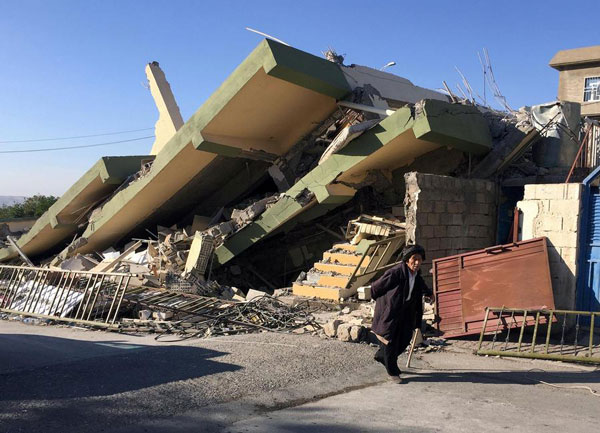當(dāng)前位置: Language Tips> 雙語(yǔ)新聞
Upsurge in big earthquakes predicted for 2018 as Earth rotation slows
分享到
據(jù)《衛(wèi)報(bào)》報(bào)道,美國(guó)科學(xué)家預(yù)測(cè),由于地球自轉(zhuǎn)減速,2018年世界各地發(fā)生大地震的幾率會(huì)大幅增加,尤其是在人口稠密的熱帶地區(qū)。研究發(fā)現(xiàn),每當(dāng)?shù)厍蜃赞D(zhuǎn)減速周期結(jié)束后,強(qiáng)震數(shù)量就會(huì)增加。據(jù)此推算,地球明年結(jié)束一個(gè)自轉(zhuǎn)減速周期后,將進(jìn)入強(qiáng)震大增的時(shí)期。2018年起,每年可能都會(huì)有20次強(qiáng)烈地震。
 |
|
A man walks past a damaged building following an earthquake in Darbandikhan reuters 2017-11-13 |
Scientists have warned there could be a big increase in numbers of devastating earthquakes around the world next year. They believe variations in the speed of Earth’s rotation could trigger intense seismic activity, particularly in heavily populated tropical regions.
科學(xué)家警告稱,明年,世界各地發(fā)生災(zāi)難性地震的次數(shù)可能會(huì)大幅度增加。他們認(rèn)為,地球自轉(zhuǎn)速度的變化可能引發(fā)強(qiáng)烈的地震活動(dòng),特別是在人口稠密的熱帶地區(qū)。
Although such fluctuations in rotation are small – changing the length of the day by a millisecond – they could still be implicated in the release of vast amounts of underground energy, it is argued.
盡管地球自轉(zhuǎn)的波動(dòng)幅度非常小,對(duì)一天的時(shí)間長(zhǎng)短影響不過(guò)千分之一秒,但有科學(xué)家認(rèn)為,這一變化仍然可能引發(fā)大量地下能量釋放。
The link between Earth’s rotation and seismic activity was highlighted last month in a paper by Roger Bilham of the University of Colorado in Boulder and Rebecca Bendick of the University of Montana in Missoula presented at the annual meeting of the Geological Society of America.
美國(guó)科羅拉多大學(xué)科學(xué)家羅杰?比爾漢姆與蒙大拿大學(xué)教授瑞貝卡?本迪克10月在美國(guó)地質(zhì)學(xué)會(huì)年會(huì)發(fā)表研究報(bào)告,指出了地球自轉(zhuǎn)和地震活動(dòng)之間的聯(lián)系。
“The correlation between Earth’s rotation and earthquake activity is strong and suggests there is going to be an increase in numbers of intense earthquakes next year,” Bilham told the Observer last week.
比爾漢姆上周對(duì)《觀察家報(bào)》表示:“地球自轉(zhuǎn)和地震活動(dòng)之間有很強(qiáng)的相關(guān)性,這意味著2018年強(qiáng)地震的次數(shù)將會(huì)增加。”
In their study, Bilham and Bendick looked at earthquakes of magnitude 7 and greater that had occurred since 1900. They found five periods when there had been significantly higher numbers of large earthquakes compared with other times.
比爾漢姆和本迪克研究了1900年后發(fā)生的所有7級(jí)以上地震。他們發(fā)現(xiàn),與其他時(shí)間相比,有五個(gè)時(shí)期的大地震次數(shù)顯著增加。
“In these periods, there were between 25 to 30 intense earthquakes a year,” said Bilham. “The rest of the time the average figure was around 15 major earthquakes a year.”
比爾漢姆稱:“在這些時(shí)期,每年發(fā)生25到30次大地震。而在其他時(shí)期,平均每年大約發(fā)生15次大地震。”
The researchers searched to find correlations between these periods of intense seismic activity and other factors and discovered that when Earth’s rotation decreased slightly it was followed by periods of increased numbers of intense earthquakes. “The rotation of the Earth does change slightly – by a millisecond a day sometimes – and that can be measured very accurately by atomic clocks,” said Bilham.
研究人員探尋了這些地震活動(dòng)劇烈的時(shí)期與其他因素之間的關(guān)聯(lián),發(fā)現(xiàn)當(dāng)?shù)厍蜃赞D(zhuǎn)速度稍微下降后,大地震頻次就會(huì)增加。比爾漢姆表示,“地球自轉(zhuǎn)速度變化微乎其微,有時(shí)只有每天千分之一秒的差別,但是原子鐘可以非常精確地測(cè)出這種變化。”
Bilham and Bendick found that there had been periods of around five years when Earth’s rotation slowed by such an amount several times over the past century and a half. Crucially, these periods were followed by periods when the numbers of intense earthquakes increased.
比爾漢姆和本迪克發(fā)現(xiàn),在過(guò)去一個(gè)多世紀(jì)里,曾經(jīng)出現(xiàn)過(guò)多個(gè)為期約五年的地球自轉(zhuǎn)減速期,每次減緩千分一秒。關(guān)鍵的是,地球自轉(zhuǎn)減速期之后,大地震次數(shù)就會(huì)增加。
“It is straightforward,” said Bilham. “The Earth is offering us a five-year heads-up on future earthquakes.”
比爾漢姆稱:“很明顯,地球向提前五年給我們發(fā)了地震預(yù)警。”
This link is particularly important because Earth’s rotation began one of its periodic slowdowns more than four years ago. “The inference is clear,” said Bilham. “Next year we should see a significant increase in numbers of severe earthquakes. We have had it easy this year. So far we have only had about six severe earthquakes. We could easily have 20 a year starting in 2018.”
這個(gè)發(fā)現(xiàn)尤為重要,因?yàn)樗哪甓嗲埃厍蜻M(jìn)入了一個(gè)自轉(zhuǎn)減速周期。“結(jié)論顯而易見(jiàn),明年我們應(yīng)該會(huì)發(fā)現(xiàn)大地震的次數(shù)顯著增加。今年一年還算平靜,目前為止我們只經(jīng)歷了6次強(qiáng)烈地震。從2018年開(kāi)始,我們每年很可能會(huì)經(jīng)歷20次大地震。”
Exactly why decreases in day length should be linked to earthquakes is unclear although scientists suspect that slight changes in the behavior of Earth’s core could be causing both effects.
目前,還不清楚地球白晝時(shí)間縮短為什么會(huì)影響地震活動(dòng),但科學(xué)家懷疑,地核行為的微妙變化可能導(dǎo)致了這兩種情況。
In addition, it is difficult to predict where these extra earthquakes will occur – although Bilham said they found that most of the intense earthquakes that responded to changes in day length seemed to occur near the equator. About one billion people live in the Earth’s tropical regions.
此外,盡管比爾漢姆稱,他們發(fā)現(xiàn)大多數(shù)白晝長(zhǎng)度變化導(dǎo)致的大地震似乎都發(fā)生在赤道附近,但很難預(yù)測(cè)這些地震的震源。大約有十億居民生活在赤道附近的熱帶地區(qū)。
英文來(lái)源:衛(wèi)報(bào)
翻譯&編輯:董靜
審校:yaning
上一篇 : 韓國(guó)高考推遲學(xué)生垃圾堆找書
下一篇 :
分享到
關(guān)注和訂閱

口語(yǔ)
關(guān)于我們 | 聯(lián)系方式 | 招聘信息
電話:8610-84883645
傳真:8610-84883500
Email: languagetips@chinadaily.com.cn